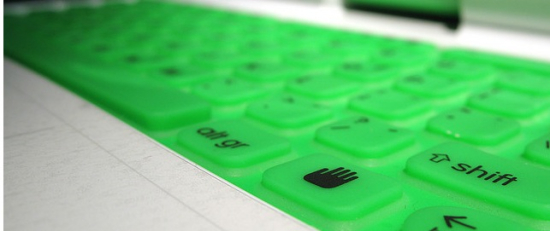
Jeff Patzer was a 2010 OLPC intern in Peru who developed several great workshops to utilize activities that would be the most useful for the kids. Unfortunately, he was held back by the XO laptop hardware, specifically the keyboard and trackpad. Just listen to him describe the issues he encountered:
First off, most kids do not know how to properly utilize the shift, alt gr, hand, and other modifier keys. At most the know how to create accents for letters, but don't understand this modifier key correlates to the other keys, and can't extend that concept further.
Second, kids will often use only one finger of one hand to type. This is an extremely slow process and while the keys are not big enough to use the keyboard normally, they are slow to adopt using two fingers on separate hands. I often explain that they should use two hands and type with two fingers because it is faster, and they do it for about 30 seconds then go back to using one hand. Now, I don't expect young kids to be able to type properly, but using two hands isn't much of a stretch.
Third, a large majority of the kids have no idea where keys are located and sometimes don't even know the letters. This is partly due to a lack of practice and partly due to how the schools teach letters. Or rather how they don't teach letters. Apparently, rather than teaching letters, they opt to teach sounds. So instead of the letter C they teach the sound Ca, Ci, etc... The best analogy I have is its like learning 2 digit numbers before learning 1 digit numbers. What this means is that not only do the kids take forever to locate keys, but they sometimes have no idea what key they should be looking for.
Fourth, the keyboards break easily. The rubber matting is easily ripped and often times keys have been replaced by tape with the letter drawn on.
Fifth, many of the keyboards are english versions. So keys like backspace say "erase" rather than "borrar". This can be quite confusing for a kid who's first language is Quecha.
Despite all these problems, the keyboard still works lightyears above and beyond the trackpad. The trackpad has a serious issue that causes it to not track. Rather, and this is due to the kids being dirty and not washing their hands causing the pad to get dirty, the pointer will jump from side to side and not function in the least. To help solve this problem I can clean the trackpad and reset the pad (press the four buttons in the corner of the keyboard at the same time), but it will only temporarily solve the issue before it reappears. The only real solution is to use a USB mouse.
Some of these issues have been addressed in an updated version of the laptops, XO-2, but this does not help any of the schools that received the first editions of the laptops.


Compared to the trackpad, the XO-1's keyboard is very useful. When I visited a laptop school in Uganda, the kids weren't touch-typists, but their only mistakes were typing extra letters or spaces.
There are typing tutor programs for the XO, if the schools are willing to teach a basic computer skill. Mongolia made it a goal of their laptop program to have typing classes, because it's crucial for using any computer. Peru's mistake here is spending less time on basics before using the laptops in lessons.
As for learning sounds rather than letters, it's called phonics. I didn't enjoy it when I was in school, but it's become almost universal in the US and is supported by a good deal of research: http://en.wikipedia.org/wiki/Phonics#Phonics_in_the_U.S.
The tricks for the touchpad have not been passed on to Jeff.
There can be a hardware problem, but an important part is to understand that there is a static charge problem cause by motion contact with the plastic pad surface.
Rubbing the hands together briskly and then touching a grounded (or large object) will reduce the electrical charge and the jumping cursor. Placing tape over the pad will reduce its sensitivity.
The touchpad would drive me crazy until I leaned the "rubbing of hands" trick -- it works all the time unless the keyboard is really broken. Hand soiling has never been a problem for me -- use gentle washing with a damp towel moistened with liquid soap. I use some eyelid cleaning pads (contains soap) sold in foil packets. Or, tape cover the touchpad and periodically replace the tape. Obviously, don't use tape having a strong adhesive.
An example tape is 3M blue masking tape used for painting. It is an easy release, nohardening tape. There is a two inch role available that allows cutting out "patches" to place over the touchpad.
Caveat: I have no experience leaving this on for many months.